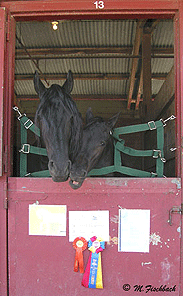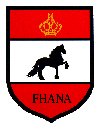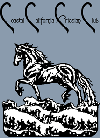FRIESIAN QUESTIONS
A: Here is my "in a nut shell" answer without going into long detail. ( I will eventually try to post a score sheet and explain it in a little more detail) what you will see is a list of conformation and characteristics with ranging scores to ether side of a Grey center line.
The Grey area Down the center of the sheet, is what would be considered the 'normal' score for a Friesian. Horses scoring in the Grey line are of the 'normal' ideal Friesian type. Horses scoring to ether side have more of the characteristics listed on that side of the Grey line. 
The Bottom Line of numbers are your totals.
Average score premium
-6 not included in studbook
~ 6 included stb, no premium
~ 6 – 7 included stb, third premium
~ 7 included stb, star, second premium
7.5+ included stb, star, first premium
Q: Can you please explain the process for showing a horse for Ster?
A: The Rules for showing for Ster on on this website under 'Showing' You should show horses in good physical condition, well groomed but a'natural. In a white headstall and bit. someone, yourself
or the other runner will act as the 'whip' ( more on that to follow) first
the horse is lead into the area and asked to stand square for the judges so
they can evaluate them, they are looking at things like, confirmation,
color, hair growth, ears, eyes, leg conformation all sorts of little thing
which they give a point score too on a form which is called a 'Linear
score sheet' ( you will get a copy of it with your new registration papers,later),
Score is mostly conformation and movement. Then the horse is walked off and walked
in a big circle (triangle) the then is trotted usually two times round the
triangle the runner will run the horse and the 'whip' acts behind the horse to get it trotting really forward by cracking the whip in the air, or
sometimes they will ( if allowed) shake a can with rocks to get the horse in an animated hyped up extended trot, (this only lasts less then a minute so there is no harm done) after that the
horses is taken out of the ring. Once all the others have gone, all of them
return and each is walked in a big circle where the judges can look at them
again. The judges will ask handlers to move horses up to the fount of the line in order
of preference. Once the judges are done, all the horses are lined up and given there
premiums. 1st, 2nd, 3rd or no premiums the 1sts and 2nds will become Ster
all the rest will still go in the studbook and get new studbook registration
papers. The horses to make Ster are then trotted on time round as and
honor round. ( you must bring your original foal book 'veulenboek' papers to give to the judges at the end of the day, these will be taken back to Holland and you horse will receive new studbook 'stamboek' papers, eventually in the mail) If you horse does not make Ster you can always try again in
another year.
Q: Can you please Give me some pointer on how to train my horse for the Kuerings?
A: Well there really is not much 'training' involved in preparing for the Kuerings. You manly want to present a horse that is in very good physical condition.
to prepare at home, I suggest you start a light regime of working your hors daily over some trotting poles. (peeler cores laid on the ground are great). Average distance is approx., 4-5" apart but will depend on your horses stride, so adjest them accordingly.
Start with 5 minutes a day each direction at the trot and build up to 10 then 20 but leave 20 as your max. (if you horse starts to show that its too tired, i.e tripping, breathing hard, bring the work load back down until you can gradually build stamina.) Start moving the poles a little further apart towards the end of your sessions so that your horse has to extent more to get over them.( Do not start that far apart)
This will provide adequate conditioning for you horse to show a powerful extended trot at the kuering. Other things you will want to do is teach you horse to stand quietly and attentively as people walk around them. Also make sure to try your kuering tack and equipment on the horse prior to the kuering. Additionally, the runner will always be on the left side of the horse with the horses moving around to the right, so thy will be on the outside of the triangle, you can walk your horse staying on the outside, to prepare him for this.
Q: Can you please Give me some groom tips for the Kuerings?
A: Ok, lets start with clipping. You can clip under the chin, muzzle hairs are optional. You can clip the ears, generally just the outside but again optional for the owner. You can Clip from the point of the horses elbow to 1 inch below the knee to make to feathers stand out more.
you CANNOT cut the mane or tail. You can have a bridle path ONLY the width of the crown of your headstall, so it cannot be seen when your horse is bridled. Horse coat should be washed with a black highlighting shampoo & show shined. Hoofs should be painted black. Hoofs can be shod or unshod, but has to be all four whatever you choose and but make sure they are in good condition, not all chipped up or due for shoeing.
Mane and tail should be fully brushed out, some people like to braid it to create waves. Feathers can be brushed out and brushed backwards to create more fluff.


